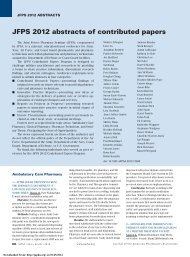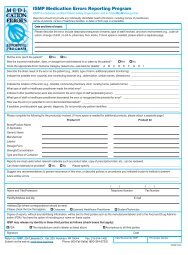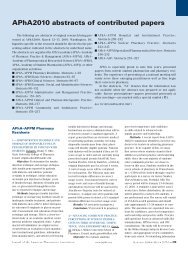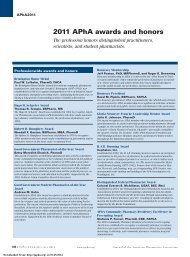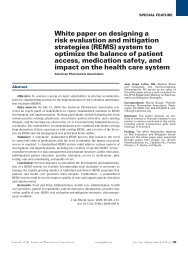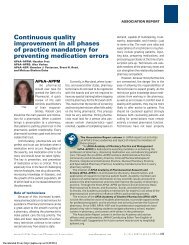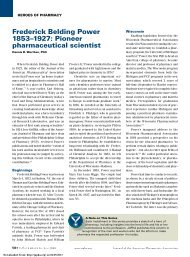Downloaded - Journal of American Pharmacists Association
Downloaded - Journal of American Pharmacists Association
Downloaded - Journal of American Pharmacists Association
You also want an ePaper? Increase the reach of your titles
YUMPU automatically turns print PDFs into web optimized ePapers that Google loves.
FEATURE Annual Meeting Abstracts 2004<br />
inputs (i.e., service quality, courses, student friendships,<br />
faculty friendships, workload, perceived<br />
accomplishment, and student organizations) and<br />
four outcomes (i.e., overall satisfaction, school<br />
commitment, perceived value, and willingness to<br />
serve). Participants: Pharmacy students in their final<br />
year <strong>of</strong> school before graduation (P-4). Data collection:<br />
Four graduating classes <strong>of</strong> students (2000 to<br />
2003) at an Southeastern University were surveyed<br />
during P-4 clerkships. Data Analysis: Descriptive<br />
and regression analyses were conducted.<br />
Results: Four separate stepwise models showed<br />
substantial explanatory power <strong>of</strong> overall satisfaction<br />
(73%), school commitment (42.4%), perceived<br />
value (50.5%), and willingness to serve (33.6%).<br />
Five <strong>of</strong> the seven educational quality inputs in the<br />
proposed framework had a significant impact on at<br />
least three <strong>of</strong> the four outcomes. Service quality had<br />
the greatest impact on overall satisfaction (R 2 =<br />
.619) and school commitment (R 2 = .307). Courses<br />
had the greatest impact on perceived value (R 2 =<br />
.384) and willingness to serve (R 2 = .200) and significant<br />
influence on overall satisfaction (R 2 = .101)<br />
and school commitment (R 2 = .064). Other important<br />
predictors were student organizations, faculty<br />
friendships, and academic accomplishments.<br />
Student friendships had no impact on any outcome,<br />
and workload had marginal impact on perceived<br />
value.<br />
Conclusions: This research demonstrates that<br />
student perceptions <strong>of</strong> the school are based upon a<br />
broad range <strong>of</strong> educational inputs including but not<br />
limited to service quality. Most important are the<br />
courses and the way they are delivered.<br />
Extracurricular activities such as participation in<br />
student organizations and interactions with faculty<br />
also influence perceptions.<br />
260—RANDOMIZED TRIAL OF A PHAR-<br />
MACIST CONSULTATION PROGRAM FOR<br />
FAMILY PHYSICIANS AND THEIR ELDER-<br />
LY PATIENTS: 17-MONTH FOLLOW-UP.<br />
Sellors C, Kaczorowski J, Sellors J, Goeree R,<br />
Dolovich L, Willan A, Woodward C, Howard M,<br />
Blackhouse G, McMaster University. E-mail: csellors1@comcast.net<br />
Objective: To report the longer term (17 months)<br />
health and economic impacts <strong>of</strong> the Seniors<br />
Medication Assessment Research Trial (SMART).<br />
Methods: The study was a pairedcluster, randomized,<br />
controlled trial. A total <strong>of</strong> 48 randomly<br />
selected pair-matched physicians and 889 <strong>of</strong> their<br />
randomly selected senior patients taking five or<br />
more medications participated and were randomized<br />
to the intervention (pharmacist consultation) group<br />
(N = 24) or the control group (N = 24). For each<br />
senior in the intervention group, a pharmacist completed<br />
a medication assessment, then discussed the<br />
written recommendations with the physician.<br />
Outcomes included health care and medication utilization<br />
and costs determined by administrative<br />
databases, control <strong>of</strong> blood pressure (BP), blood<br />
glucose, glycosylated hemoglobin, and cholesterol<br />
(by chart audit), medication appropriateness measured<br />
by a published tool, and quality <strong>of</strong> life.<br />
Analyses are based on the 12 months (phase 2) after<br />
the 5-month intervention period and took account <strong>of</strong><br />
the cluster design.<br />
Results: A total <strong>of</strong> 779 seniors (374 intervention<br />
group, 405 control group) participated in phase 2.<br />
Seniors in both groups were 74 years <strong>of</strong> age on average,<br />
and approximately two thirds were female.<br />
<strong>Pharmacists</strong> identified 1,093 drug-related problems<br />
in the intervention group. During the 12 months <strong>of</strong><br />
phase 2, seniors in the intervention and control<br />
groups filled a similar average number <strong>of</strong> prescriptions<br />
(34.6 versus 33.9, respectively, P = .81), and<br />
had a similar number <strong>of</strong> hospitalizations (0.27 versus<br />
0.33, respectively, P = .38). The total average<br />
cost (including the pharmacist consultation in that<br />
group) in the intervention and control groups over<br />
the 12 months was $5,042.72 versus $4,781.49, P =<br />
.67. The proportions <strong>of</strong> seniors with hypertension,<br />
hypercholesterolemia, and diabetes, who had<br />
uncontrolled (including an absence <strong>of</strong> any readings<br />
in the chart) BP, cholesterol, and blood glucose<br />
were high in both groups (58%–95%), and were not<br />
statistically significantly different between groups<br />
after taking account <strong>of</strong> baseline group imbalances.<br />
Conclusions: The one-time pharmacist consultation<br />
intervention did not result in changes in health<br />
care utilization or clinical management <strong>of</strong> hypertension,<br />
diabetes, or hyperlipidemia, but demonstrated<br />
a need to address drug-related problems and a successful<br />
collaboration process between pharmacists<br />
and physicians.<br />
Original Citation: Canadian <strong>Association</strong> for<br />
Population Therapeutics, Quebec City, Quebec,<br />
Canada, March 31, 2003.<br />
261—RATES AND IMPLICATIONS OF<br />
DRUG COST IMPUTATIONS IN THE MEDI-<br />
CARE CURRENT BENEFICIARY SURVEY.<br />
Mott D, Kreling D, Chou C, University <strong>of</strong><br />
Wisconsin–Madison. E-mail: damott@pharmacy.<br />
wisc.edu<br />
Objective: The objectives <strong>of</strong> this study were to<br />
examine trends in the rates <strong>of</strong> statistical imputation<br />
for drug cost data in the MCBS data, determine how<br />
those rates vary by drug coverage source, and<br />
explore potential implications <strong>of</strong> those imputations<br />
on resulting drug cost and out-<strong>of</strong>-pocket cost estimates.<br />
Methods: Data on prescription drug use and<br />
spending for persons age 65 and older from the<br />
Medicare Current Beneficiary Survey (MCBS) Cost<br />
and Use Files from 1994 to 1999 were used. A variable<br />
identifying whether drug cost information for<br />
prescribed medicine events was statistically imputed<br />
was used to track rates <strong>of</strong> imputation. The effects<br />
<strong>of</strong> statistical imputation were examined with data<br />
from 1994 by comparing summary cost variables<br />
calculated using all prescribed medicine events,<br />
using only prescribed events that did not have<br />
imputed costs and using prescribed medicine events<br />
only for persons with no imputed medicine events.<br />
Results: The general trend for out-<strong>of</strong>-pocket was<br />
an increase in the rate <strong>of</strong> statistical imputation each<br />
year. The least amount <strong>of</strong> imputations occurred<br />
among the no coverage group. In terms <strong>of</strong> total<br />
spending, the rates <strong>of</strong> statistical imputation were<br />
more consistent across the years, and lower than<br />
those for out-<strong>of</strong>-pocket costs except for the<br />
Medicaid-covered group. Imputation effects on estimates<br />
<strong>of</strong> drug use and cost occurred when prescriptions<br />
with imputation were removed or persons with<br />
imputation were removed.<br />
Conclusions: Variation in rates <strong>of</strong> statistical<br />
imputation for drug cost information in the MCBS<br />
data among seniors with different drug coverages, a<br />
trend toward more statistical imputations over time,<br />
and higher amounts <strong>of</strong> out-<strong>of</strong>-pocket cost and drug<br />
costs in cases <strong>of</strong> imputation suggests caution is warranted<br />
by users <strong>of</strong> these data and the results <strong>of</strong> studies<br />
based on these data.<br />
262—RESORPTIVE DRUG USE PAT-<br />
TERNS AMONG MINNESOTA FEMALES:<br />
RESULTS OF A STATEWIDE SURVEY. Farley<br />
J, Cline R, University <strong>of</strong> Minnesota, Hansen R,<br />
University <strong>of</strong> North Carolina at Chapel Hill. E-mail:<br />
farl0032@umn.edu<br />
Objective: A number <strong>of</strong> drugs (referred to as<br />
resorptive medications) including antiepileptics,<br />
loop diuretics, and corticosteroids can reduce bone<br />
mineral density in users and ultimately increase<br />
their risk <strong>of</strong> osteoporosis. Although the use <strong>of</strong><br />
resorptive medications can positively affect the<br />
health <strong>of</strong> users, few studies have examined their<br />
prevalence or predictors <strong>of</strong> use. Primary objectives<br />
were to (1) establish the prevalence <strong>of</strong> use <strong>of</strong> resorptive<br />
medications in Minnesota women aged 45 or<br />
older and (2) describe factors associated with<br />
resorptive medication use. Secondary objectives<br />
were to explore the occurrence <strong>of</strong> osteoporosis and<br />
osteopenia as well as the use <strong>of</strong> newer antiresorptive<br />
medications, calcium, and hormone-replacement<br />
therapy (HRT) among women using resorptive<br />
drugs.<br />
Methods: Design: Secondary data analysis <strong>of</strong> a<br />
cross-sectional mailed survey. Instrumentation: 75-<br />
item questionnaire with 5 sections including health<br />
belief model constructs, medication pr<strong>of</strong>iles, and<br />
demographics. Participants: Survey forms were<br />
mailed to 1,700 community-dwelling women aged<br />
45 and older residing in Minnesota. Analyses: Chisquare<br />
analysis and logistic regression were used to<br />
test bivariate and multivariate relationships between<br />
demographic variables, health characteristics,<br />
resorptive medications, and use <strong>of</strong> newer antiresorptives,<br />
calcium, and HRT.<br />
Results: A total <strong>of</strong> 990 usable survey forms were<br />
returned (adjusted response rate <strong>of</strong> 61.1%). Eightyfour<br />
respondents (8.5%) reported use <strong>of</strong> a resorptive<br />
medication. Age, health status, and health care utilization<br />
(monthly physician visits and prescription<br />
use) were all associated with resorptive medication<br />
use, controlling for other variables in the model.<br />
Women using resorptive drugs were more likely to<br />
report osteopenia or osteoporosis, were more likely<br />
to report using an antiresorptive medication but were<br />
not more likely to report using HRT or calcium.<br />
Conclusions: Resorptive medication use was<br />
common among respondents and was correlated<br />
with diagnoses <strong>of</strong> osteoporosis or osteopenia.<br />
292 <strong>Journal</strong> <strong>of</strong> the <strong>American</strong> <strong>Pharmacists</strong> <strong>Association</strong> www.japha.org March/April 2004 Vol. 44, No. 2<br />
<strong>Downloaded</strong> From: http://japha.org/ on 01/25/2014



